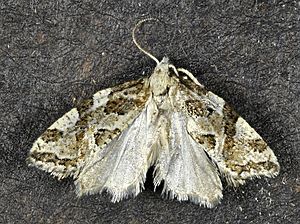Aethes sexdentata facts for kids
Quick facts for kids Aethes sexdentata |
|
|---|---|
 |
|
| Scientific classification |
Aethes sexdentata is a small, interesting moth from the family Tortricidae. This family includes many moths that are often called "leaf-rollers" because their caterpillars sometimes roll up leaves. This particular moth lives in North America.
Contents
Where Does It Live?
You can find Aethes sexdentata in many parts of North America. It has been seen in places like Nova Scotia, Ontario, and Quebec in Canada. In the United States, it lives in states such as Connecticut, Illinois, Indiana, Maine, Massachusetts, Michigan, Minnesota, Mississippi, Nebraska, New Jersey, Pennsylvania, Vermont, Washington, West Virginia, and Wisconsin.
This moth prefers to live in certain types of places. Its favorite homes are in openings within deciduous forests. These are forests where trees lose their leaves in the fall. It also likes areas with lots of blueberry bushes.
What Does It Look Like?
The Aethes sexdentata moth is quite small. Its front wings, called forewings, are usually between 5.7 and 8.2 millimeters long. That's less than half an inch!
The main color of its forewings is white. However, they are also sprinkled with buff-colored scales. This gives them a slightly dusty or creamy look. The hindwings, which are the back wings, are a dark drab color.
Its Life Cycle
Adult Aethes sexdentata moths are active during the warmer months. They have been seen flying from May all the way through August. Scientists believe that these moths likely have one generation each year. This means that the eggs laid in one year grow into adults that same year, and then those adults lay eggs for the next year's generation.
What Do Its Babies Eat?
The young moths, which are called larvae or caterpillars, have a specific diet. They enjoy eating plants from the Solidago family. Goldenrod is a common plant with bright yellow flowers that you might see growing in fields and along roadsides.
Why Is It Called That?
The name sexdentata comes from Latin. It refers to special spines found on a part of the male moth's body called the harpe. These spines are like tiny teeth, and "sexdentata" means "six-toothed."

